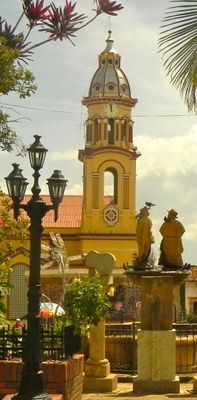A Spanish colonial town with white-washed buildings and South America's largest central plaza, set against the backdrop of Andean mountains in Boyacá.
Villa de Leyva, a 16th-century Spanish colonial town in Colombia's Boyacá department, takes you back in time with stone streets and white-painted buildings. At its center lies Plaza Mayor, South America's largest stone-paved square framed by arched walkways holding coffee shops and artisanal stores. Dig into history at museums displaying marine reptile fossils from when this area lay under an ancient sea. Trek through Iguaque National Park to find waterfalls and a glacial lake once sacred to indigenous people. Time your visit for August's kite-filled skies or December's candlelit streets, and don't miss the odd stone pillars at El Infiernito that track sun positions.
Exploring Colonial Architecture and Plaza Mayor
Walk Villa de Leyva's grid of stone streets laid out in 1572, where buildings still follow original Spanish design rules. The 14,000-square-meter Plaza Mayor centers around a hexagonal fountain built in Moorish style during the town's founding years. Look up at the Iglesia de Nuestra Señora del Rosario's gold-covered altar, completed in 1608 using baroque techniques. Former colonial mansions around the square now serve as town hall offices, small hotels selling wool rugs, and shops with leather goods. Keep your eyes on the ground – some stones in walls and pathways contain spiral-shaped fossils from creatures that lived here 120 million years ago. On weekends, farmers sell peaches and potatoes from wooden carts near the fountain as evening brings guitar players to restaurant patios.
Discovering Fossils and Ancient Sea Life
At Museo El Fósil, three miles from town, a 24-foot marine reptile skeleton sits exactly where farmers uncovered it in their field in 1977. Guides explain how this Kronosaurus swam through warm seas that covered the region during the dinosaur age. Back in town, the Paleontology Museum displays 441 smaller fossils including coiled ammonite shells and palm leaf imprints pressed into stone. Several local companies take visitors to dig sites where you can split shale slabs to find your own fossilized clams or fish scales. While shops sell polished ammonite pieces as jewelry, remember that taking large fossils out of Colombia needs government paperwork.
Festivals and Seasonal Events
August turns Villa de Leyva's skies into a mosaic of kites during the International Festival, where competitors fly 100-foot-long fabric dragons. December's Festival of Lights sees every balcony on Plaza Mayor decorated with candles in glass jars, creating patterns visible from nearby hills. The October Tree Festival teaches grafting techniques for Andean oaks through free workshops in the main square. Music fills the air every July when saxophonists and drummers arrive for the Jazz Under the Mountains concert series. Food stalls dominate November's Gastronomy Festival, serving goat stew cooked in clay pots and arepas filled with fresh cheese. Reserve hotels early for these events – some require bookings six months ahead.
Hiking and Natural Attractions
Iguaque National Park's most popular trail climbs 2,100 feet over three miles to reach a round lake formed by glaciers. Muisca guides share stories about how their ancestors believed this lake birthed humanity while pointing out frailejón plants with silver leaves. Closer to town, the Pozos Azules water pools glow bright blue due to mineral deposits in their clay-lined basins, creating sharp color contrasts against yellow hills. Adventure groups lead climbs down the 98-foot La Periquera waterfall using harnesses, or arrange horse rides past cactus fields to El Infiernito's stone circle. Rent bicycles to pedal through vineyards like Viñedo Ain Karim, where winemakers grow grapes at 7,200 feet elevation.
Nearby Historical Sites and Workshops
El Infiernito's 2,000-year-old stone pillars arranged in lines and circles served as a calendar for pre-Spanish farmers tracking seasonal shifts. Archaeologists believe the 109 phallic stones helped determine planting times through shadow measurements. The 1620 Convento del Santo Ecce Homo monastery sits 9 miles northeast, its painted chapel ceilings showing star patterns used by monks to calculate Easter dates. In Ráquira village, potters shape clay into drinking vessels using methods shown to them by Muisca ancestors, baking pieces in open kilns. Don't miss Casa Terracota – this working house made entirely from baked earth includes a functional bathroom and kitchen built without conventional materials.
Food and Local Specialties
Plaza Mayor restaurants specialize in trout caught daily from mountain streams, served either fried with capers or baked in tomato sauce. At the covered market, vendors sell paper cones filled with toasted ants that taste similar to smoky peanuts – try them with a squeeze of lime. Morning meals focus on tamales boyacenses: corn dough stuffed with chicken and peas, steamed inside banana leaves for six hours. HISCA Brewery experiments with local ingredients, adding coffee beans from nearby Arcabuco to their amber ale or lulo fruit to wheat beers. For quick snacks, bakeries near Antonio Ricaurte Park sell warm cheese breads made with cassava flour, best eaten fresh with small cups of black coffee.
Visiting Tips and Logistics
Bring a jacket for cool nights at 7,000 feet elevation – days might feel warm at 75°F, but temperatures plunge after sunset. Wear shoes with thick soles to navigate uneven streets made of large river stones. Direct buses from Bogotá's Terminal del Norte station take four hours via winding mountain roads; sit on the right side for views of sunflower fields near Samacá. While some hotel staff speak English, taxi drivers and market vendors usually don't – learn phrases like "¿Cuánto cuesta?" for smoother interactions. Colonial-era guesthouses provide the most authentic stays, many with original tile floors and inner gardens. Most museums charge between $1.50 to $3 USD for entry, with last admission at 4:30 PM.










